 A visual communications company, All New Video, have announced a deal with BBC to enable feedback and input into TV programmes from viewers, video calling from 3G phones, Web cams and ISDN. On the voice side, it will add VoIP to its inbound voice channels.
A visual communications company, All New Video, have announced a deal with BBC to enable feedback and input into TV programmes from viewers, video calling from 3G phones, Web cams and ISDN. On the voice side, it will add VoIP to its inbound voice channels.
It will open up and encourage the input of BBC viewers into news television programmes, widening the chances for user-generated content. The first show will be ‘Have Your Say’ which is aired on BBC World and BBC News 24, which they hope will before the end of the month.
We think this is a really exciting idea, with the live element being the real revolution. We spoke to David Hogben, General Manager, to get the low down.
Webcam to Live Broadcast
During live shows, the producer will be able to ask viewers to join in with the programme, by connecting with their 3G mobiles (unlikely and expensive for the caller), or far more interestingly, their Webcams.
To get to add their two penny worth, prospective video chatters will go to the BBC News Web site and download an ActiveX control (sorry Windows only currently), which will pick up their Webcam and/or microphone, letting them connect.
As the Application can be downloaded by anyone, input can come from anywhere worldwide.
 The system give the assistant producer the ability to carry out a video chat with the viewer letting them ascertain their suitability of the show – frankly, filter out those not relevant. Each person can also be ranked and some notes made about them.
The system give the assistant producer the ability to carry out a video chat with the viewer letting them ascertain their suitability of the show – frankly, filter out those not relevant. Each person can also be ranked and some notes made about them.
When the assistant producer thinks they’ve got the best of the bunch, they are passed in to a ‘waiting room’ where the producer can also chat with them, and then they decide if it’s time to put them live into the broadcast. As the 3G video is low res and the Webcam quality variable, it’s likely that video feeds will only be broadcast at quarter screen resolution for the time being.
The whole process runs through a Web-browser on All New Video’s servers, until the broadcast, when a server at the BBC is connected with, feeding the video and audio out through an SDI interface.
Video comments
Those old enough will remember UK broadcaster, Channel 4, used to have ‘feedback booths’ in a couple of UK cities where viewers were able to go into a darkened box and share their views with the UK audience.
 The new BBC system will let people do the same from the safety of their own bedrooms, where they’ll be able to leave their five minutes of video wisdom in a video mail system.
The new BBC system will let people do the same from the safety of their own bedrooms, where they’ll be able to leave their five minutes of video wisdom in a video mail system.
Background on All New Video
All New Video started in 2002 with the advent of 3G as they thought it would address a lot of the problems the founder, David Atkins, had encountered in their previous video conferencing business.
Their first big business win was a contact with Orange to supply the technology for their video answering service. Any time you can’t get through to someone with a video call on a 3G or 2.5G phone, you’re connected to the All New Video kit, where you can leave up to a 30 second message which is then delivered via MMS.
As we’ve been hearing from Vodafone recently, video calling isn’t being embraced by the 3G owning public, neither, more widely, is 3G. This lead to a rethink for them and a switch to including Webcams and other Internet technologies such as VoIP to be included.
They’ve previously done deals with two UK TV companies ITN and ITV’s breakfast show, GMTV. Neither are advanced as the BBC system advised today, with the ITN handling video messaging and the GMTV allowing video calls going direct to air, both from 3G phones.
All New Video
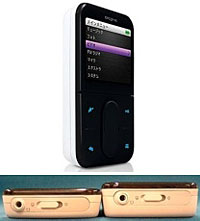 Fresh outta hi-tech Fat Farm, the new Zen Vision M and W models have managed to reduce their bulk by 15% on previous versions while wedging in a bigger hard disk.
Fresh outta hi-tech Fat Farm, the new Zen Vision M and W models have managed to reduce their bulk by 15% on previous versions while wedging in a bigger hard disk.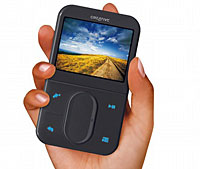 The rather desirable little fella weighs in at a light as heck 170g (and that includes the battery) and comes with a 2.5 inch colour screen.
The rather desirable little fella weighs in at a light as heck 170g (and that includes the battery) and comes with a 2.5 inch colour screen.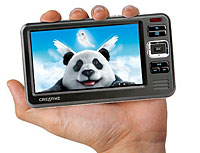 Vision W
Vision W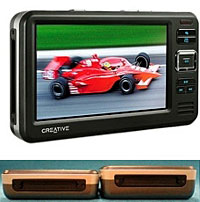 When?
When?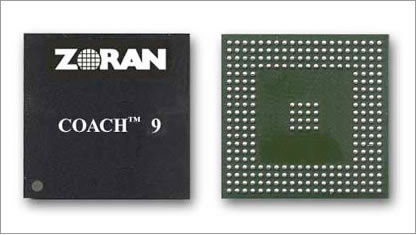
 Apple have just announced that they have signed deals with six major airlines, offering the first seamless integration between iPod and the planes in-flight entertainment systems.
Apple have just announced that they have signed deals with six major airlines, offering the first seamless integration between iPod and the planes in-flight entertainment systems.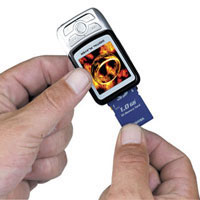 Smaller than a pixie’s pocket plaything, the ridiculously tiny Ultra Portable Personal Media Player and Recorder is quite the teensiest thing we’ve seen for a while.
Smaller than a pixie’s pocket plaything, the ridiculously tiny Ultra Portable Personal Media Player and Recorder is quite the teensiest thing we’ve seen for a while.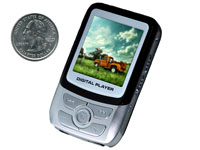 Lord knows how they’ve managed to fit it in, but there’s also a speaker onboard too, although we imagine the output must be quieter than a gnat having a snooze.
Lord knows how they’ve managed to fit it in, but there’s also a speaker onboard too, although we imagine the output must be quieter than a gnat having a snooze.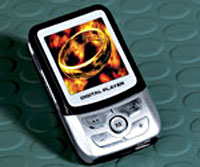 It’s as cheap as chips too, with Gadget Universe offering it for just $80 (£42, €62).
It’s as cheap as chips too, with Gadget Universe offering it for just $80 (£42, €62).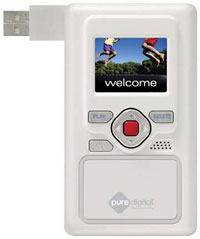 Pure Digital Technologies has announced a cheapo camcorder that can upload movies to video sharing Web sites like Google Video with a single click.
Pure Digital Technologies has announced a cheapo camcorder that can upload movies to video sharing Web sites like Google Video with a single click. Allen Weiner, an analyst with market tracker Gartner, reckoned Pure Digital were on to a winner, describing the pint-size camcorder as “simple, but also revolutionary.”
Allen Weiner, an analyst with market tracker Gartner, reckoned Pure Digital were on to a winner, describing the pint-size camcorder as “simple, but also revolutionary.”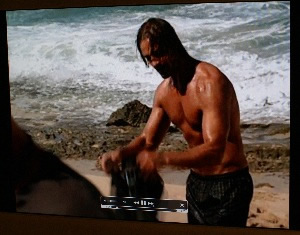 Apple has for once pre-announced a new product, codenamed iTV (which is unlikely to be the final name as they’d get sued in the UK for a start).
Apple has for once pre-announced a new product, codenamed iTV (which is unlikely to be the final name as they’d get sued in the UK for a start).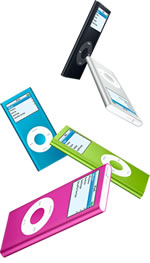 In the UK, the iTunes music store was closed all day yesterday for refurbishment, with a black screen just saying ‘Showtime.’ At about 6pm (UK time) Steve Jobs announced why. There’s a slew of new/updated iPods and more content on the store as well as version 7 of iTunes for Mac and Windows (more on this later).
In the UK, the iTunes music store was closed all day yesterday for refurbishment, with a black screen just saying ‘Showtime.’ At about 6pm (UK time) Steve Jobs announced why. There’s a slew of new/updated iPods and more content on the store as well as version 7 of iTunes for Mac and Windows (more on this later). Movies (and video from the iTunes store) are now stored in 640 x 480 format.
Movies (and video from the iTunes store) are now stored in 640 x 480 format.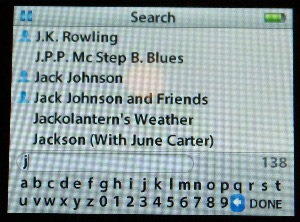 Both the Nano and iPod video now have search features so that albums can be searched for etc., using the click wheel (with on-screen letters and search criteria). Gapless playback is a new feature, so songs can be played continuously without the normal two second wait between songs. There’s no beat matching yet, but maybe that’s Apple’s next enhancement so DJ’s will be out of a job.
Both the Nano and iPod video now have search features so that albums can be searched for etc., using the click wheel (with on-screen letters and search criteria). Gapless playback is a new feature, so songs can be played continuously without the normal two second wait between songs. There’s no beat matching yet, but maybe that’s Apple’s next enhancement so DJ’s will be out of a job. A visual communications company, All New Video, have announced a deal with BBC to enable feedback and input into TV programmes from viewers, video calling from 3G phones, Web cams and ISDN. On the voice side, it will add VoIP to its inbound voice channels.
A visual communications company, All New Video, have announced a deal with BBC to enable feedback and input into TV programmes from viewers, video calling from 3G phones, Web cams and ISDN. On the voice side, it will add VoIP to its inbound voice channels.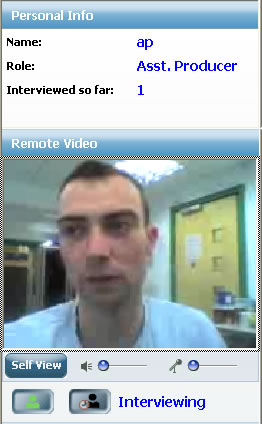 The system give the assistant producer the ability to carry out a video chat with the viewer letting them ascertain their suitability of the show – frankly, filter out those not relevant. Each person can also be ranked and some notes made about them.
The system give the assistant producer the ability to carry out a video chat with the viewer letting them ascertain their suitability of the show – frankly, filter out those not relevant. Each person can also be ranked and some notes made about them.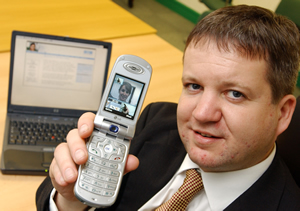 The new BBC system will let people do the same from the safety of their own bedrooms, where they’ll be able to leave their five minutes of video wisdom in a video mail system.
The new BBC system will let people do the same from the safety of their own bedrooms, where they’ll be able to leave their five minutes of video wisdom in a video mail system.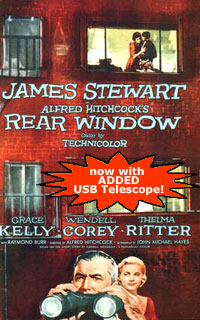 If you enjoyed Hitchcock’s Rear Window movie, you can now play a James Stewart character in your very own home thanks to Brando’s new USB Web Cam With Telescope.
If you enjoyed Hitchcock’s Rear Window movie, you can now play a James Stewart character in your very own home thanks to Brando’s new USB Web Cam With Telescope.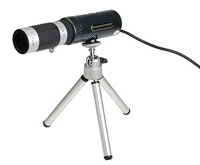 The manual focus Webcam also offers video with a frame rate of 30fps at 320×240 and 15fps at 640×480.
The manual focus Webcam also offers video with a frame rate of 30fps at 320×240 and 15fps at 640×480. Being a Brando product, it’s as cheap as chips – just $26 – and only available via mail order from Hong Kong.
Being a Brando product, it’s as cheap as chips – just $26 – and only available via mail order from Hong Kong. Logitech has dished out some details on their new QuickCam Ultra Vision Webcam, which they claim offers, “a true-to-life video calling experience by delivering twice the image clarity as that offered by typical Webcams.”
Logitech has dished out some details on their new QuickCam Ultra Vision Webcam, which they claim offers, “a true-to-life video calling experience by delivering twice the image clarity as that offered by typical Webcams.”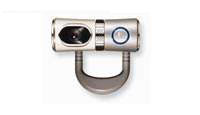 Unfortunately, Logitech haven’t released any proper photos of the Webcam or posted up any examples of the image quality, so I guess we’ll have to wait to see if the it’s as good as they say.
Unfortunately, Logitech haven’t released any proper photos of the Webcam or posted up any examples of the image quality, so I guess we’ll have to wait to see if the it’s as good as they say.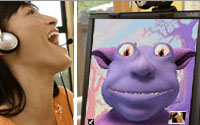 We’re sure children under 10 years old (and some cray-zee tie wearing office pranksters) will get more pleasure than we did out of using the included ‘Video Effects’ software.
We’re sure children under 10 years old (and some cray-zee tie wearing office pranksters) will get more pleasure than we did out of using the included ‘Video Effects’ software.